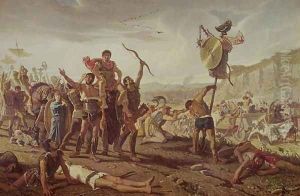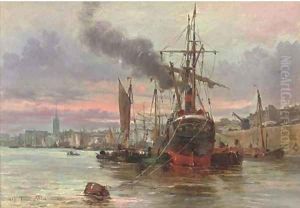Saverio Altamura Paintings
Saverio Altamura was an Italian painter, born in 1822 in Foggia, Apulia, Italy. He was a prominent figure in the 19th-century Italian art movement, particularly known for his historical and biblical subjects. Altamura showed a strong interest in art from an early age. His artistic training began in Naples at the Royal Institute of Fine Arts, where he studied under the guidance of significant teachers of the time, such as Costanzo Angelini and Giuseppe Bonolis.
Altamura's early works were influenced by the Neoclassical style, which was prevalent in Europe at the time. However, he soon developed an interest in the nascent Romantic movement, which began to influence his work. His travels to Rome in the 1840s brought him into contact with the Nazarenes, a group of German Romantic painters who aimed to revive the spirituality and simplicity of medieval art. This encounter further impacted his style and thematic choices.
During the revolutionary period of 1848, Altamura participated in the Roman Republic, an experience that deeply affected him and inspired some of his later works. After the fall of the Roman Republic, he moved to Florence, where he became part of the Macchiaioli group, a circle of Italian artists who were proponents of the Macchiaioli style, characterized by its loose brushwork and emphasis on light and color. Although Altamura was associated with the group, his style remained distinct, retaining a more traditional and academic quality.
In Florence, Altamura became a professor at the Academy of Fine Arts and married fellow painter, the Greek-born Eleni Boukoura. They had a son, Francesco Saverio Altamura, who also became a painter. Throughout his career, Altamura exhibited his works in various Italian cities and received several commissions for his historical and religious paintings. Some of his notable works include 'Ignotus' and 'The Daughter of Jephthah'.
Altamura's later works were marked by a return to religious and historical themes, and he continued painting until his death in Florence in 1897. His legacy in the Italian art world is significant, as he contributed to the development of 19th-century painting, blending classical traditions with the emerging trends of his time. Today, Altamura's works are displayed in various Italian museums, including the Galleria dell'Accademia in Florence, testifying to his enduring impact on Italian art.

